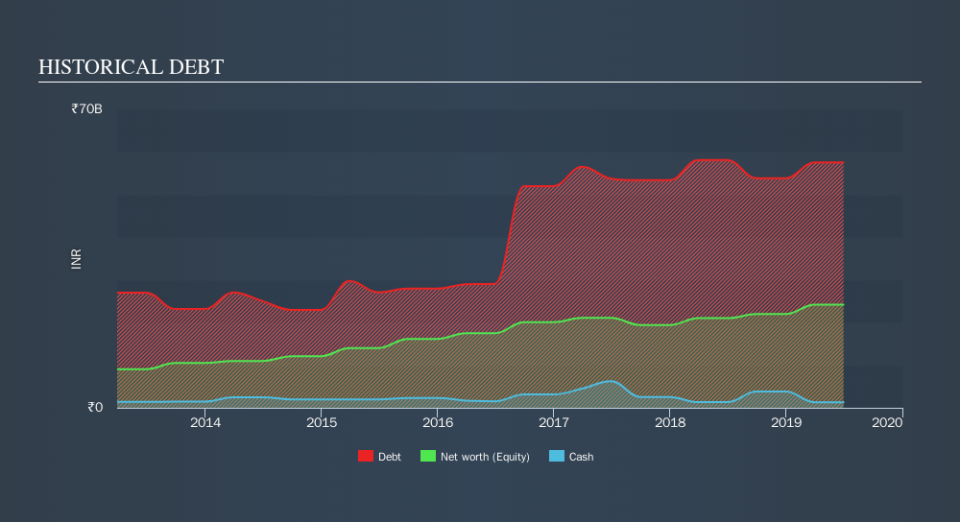Is JK Tyre & Industries (NSE:JKTYRE) A Risky Investment?

Warren Buffett famously said, 'Volatility is far from synonymous with risk.' It's only natural to consider a company's balance sheet when you examine how risky it is, since debt is often involved when a business collapses. We can see that JK Tyre & Industries Limited (NSE:JKTYRE) does use debt in its business. But the more important question is: how much risk is that debt creating?
Why Does Debt Bring Risk?
Generally speaking, debt only becomes a real problem when a company can't easily pay it off, either by raising capital or with its own cash flow. If things get really bad, the lenders can take control of the business. However, a more usual (but still expensive) situation is where a company must dilute shareholders at a cheap share price simply to get debt under control. Of course, debt can be an important tool in businesses, particularly capital heavy businesses. When we think about a company's use of debt, we first look at cash and debt together.
View our latest analysis for JK Tyre & Industries
What Is JK Tyre & Industries's Net Debt?
The chart below, which you can click on for greater detail, shows that JK Tyre & Industries had ₹57.6b in debt in March 2019; about the same as the year before. However, because it has a cash reserve of ₹1.32b, its net debt is less, at about ₹56.3b.
How Strong Is JK Tyre & Industries's Balance Sheet?
We can see from the most recent balance sheet that JK Tyre & Industries had liabilities of ₹46.4b falling due within a year, and liabilities of ₹42.6b due beyond that. Offsetting this, it had ₹1.32b in cash and ₹21.0b in receivables that were due within 12 months. So it has liabilities totalling ₹66.7b more than its cash and near-term receivables, combined.
This deficit casts a shadow over the ₹16.3b company, like a colossus towering over mere mortals. So we'd watch its balance sheet closely, without a doubt After all, JK Tyre & Industries would likely require a major re-capitalisation if it had to pay its creditors today.
We use two main ratios to inform us about debt levels relative to earnings. The first is net debt divided by earnings before interest, tax, depreciation, and amortization (EBITDA), while the second is how many times its earnings before interest and tax (EBIT) covers its interest expense (or its interest cover, for short). This way, we consider both the absolute quantum of the debt, as well as the interest rates paid on it.
Weak interest cover of 1.4 times and a disturbingly high net debt to EBITDA ratio of 5.5 hit our confidence in JK Tyre & Industries like a one-two punch to the gut. The debt burden here is substantial. More concerning, JK Tyre & Industries saw its EBIT drop by 7.9% in the last twelve months. If it keeps going like that paying off its debt will be like running on a treadmill -- a lot of effort for not much advancement. There's no doubt that we learn most about debt from the balance sheet. But ultimately the future profitability of the business will decide if JK Tyre & Industries can strengthen its balance sheet over time. So if you want to see what the professionals think, you might find this free report on analyst profit forecasts to be interesting.
Finally, while the tax-man may adore accounting profits, lenders only accept cold hard cash. So it's worth checking how much of that EBIT is backed by free cash flow. Over the last three years, JK Tyre & Industries reported free cash flow worth 2.6% of its EBIT, which is really quite low. For us, cash conversion that low sparks a little paranoia about is ability to extinguish debt.
Our View
On the face of it, JK Tyre & Industries's interest cover left us tentative about the stock, and its level of total liabilities was no more enticing than the one empty restaurant on the busiest night of the year. And even its conversion of EBIT to free cash flow fails to inspire much confidence. Taking into account all the aforementioned factors, it looks like JK Tyre & Industries has too much debt. That sort of riskiness is ok for some, but it certainly doesn't float our boat. Above most other metrics, we think its important to track how fast earnings per share is growing, if at all. If you've also come to that realization, you're in luck, because today you can view this interactive graph of JK Tyre & Industries's earnings per share history for free.
If, after all that, you're more interested in a fast growing company with a rock-solid balance sheet, then check out our list of net cash growth stocks without delay.
We aim to bring you long-term focused research analysis driven by fundamental data. Note that our analysis may not factor in the latest price-sensitive company announcements or qualitative material.
If you spot an error that warrants correction, please contact the editor at editorial-team@simplywallst.com. This article by Simply Wall St is general in nature. It does not constitute a recommendation to buy or sell any stock, and does not take account of your objectives, or your financial situation. Simply Wall St has no position in the stocks mentioned. Thank you for reading.


